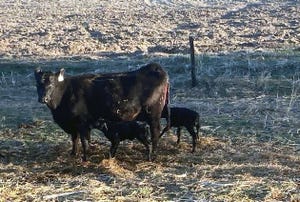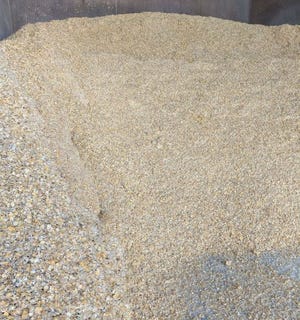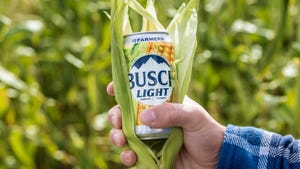How high is too high to pay for cow replacements in 2023?
Likelihood of drought impacting future cull rates and cow replacement cows appears low.
July 7, 2023
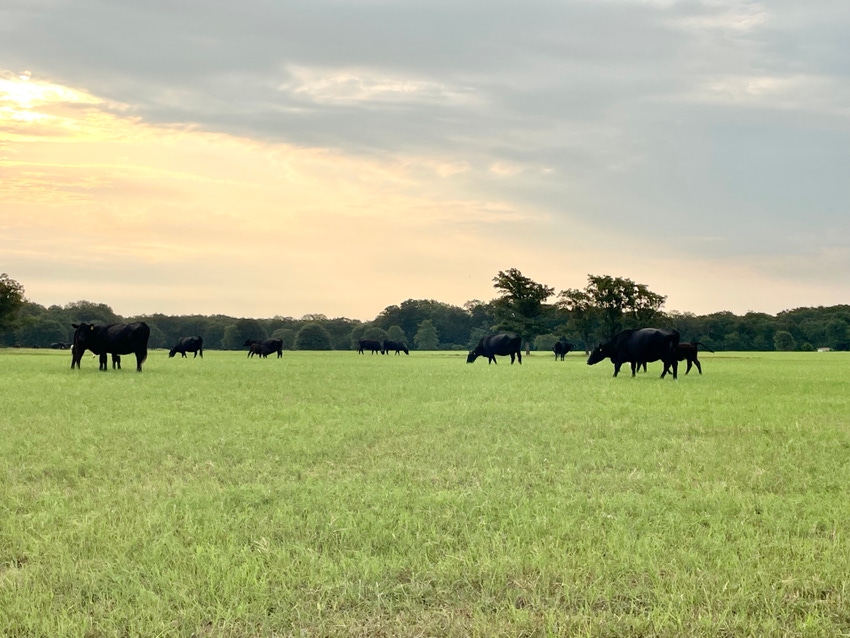
Cattle prices are up. There's no doubt about that. For example, Nebraska feeder cattle prices have risen significantly over the last four months. Nominally prices are at or higher than where we were in the 2013 to 2015 cycle. June 2023 average monthly prices for 500-600 lb. steers were approximately $300/cwt. The November Feeder Cattle contract at the CME stumbled down through June as the corn market rallied but has since recovered and broken previous price resistance levels into $252/cwt. But as summer begins to come to an end, producers will soon begin to make decisions about early weaning and cow sell/retention. Producers looking to buy cows in 2023 need to know how high is too high or in other words, what must go right to pay back the full cost of that cow.
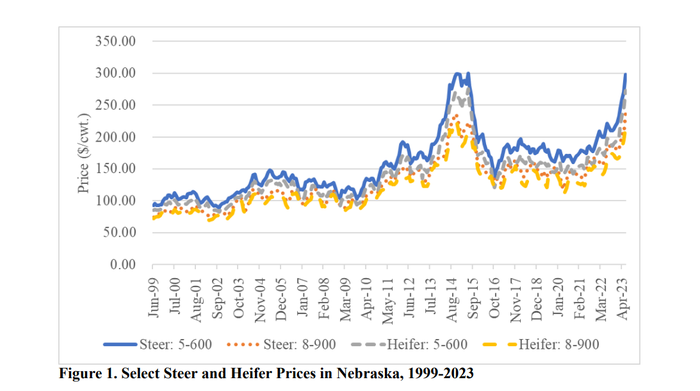
How much should I pay for a heifer this fall? The answer…It depends. Typical answer from an economist, right? So, what does it depend on? It requires producers to make expectations about current and future market conditions. These market conditions generally include animal productivity, calf prices, inflation, cow inventories, weather events, etc. all of which contribute to the value of a replacement cow. Ultimately, these factors combine to produce a single breakeven value but for simplicity, let’s take each factor separately to see how movement in either direction affects the value we are willing to pay for a cow today.
Productive life: Each cow has a useful or productive life – some are long, and some are short. The longer she lives, the more value she has. This productive life has a direct tie to the cull rates of the whole herd. While cull rates vary by year and age of cows, they may be used as a rough measure of average cow life. If a rancher has an average annual cull rate of 16%, on average a cow lasts 6.25 years in that herd (100/16=6.25).
Cow productivity: This is separate from the productive life of a cow and is typically measured in terms of the weaning weight of calves. The size and number of calves weaned and sold per cow exposed to a bull will alter this value considerably. Heavier weaning weights imply more income generated per cow and thus one can pay for replacements.
Cow costs: If weaning weights were all that mattered, we would raise extremely large cows. But large cows tend to cost more and have larger maintenance costs. What it costs (what it truly costs) to run a cow impacts the value. The higher the cost, the less one can afford to pay for replacements.
Salvage value: If the expected salvage or cull value is expected to increase over time then, what one can afford to pay increases. In the past, these values have been fairly low, but in the past few years, they have been much higher.
Calf prices: If cattle prices over the productivity life of the cow are expected to be high (or higher) on average, then what one can pay for replacements increases. Understanding the cattle cycle dynamics here is important.
Interest rates: Higher feeder cattle interest rates imply more expensive borrowing costs and thus less one can pay for replacements. Over the past 15 years, interest rates have been declining, but in the last 6 months, they have jumped significantly – from about 5.5% to 8.2%. If you are not borrowing money, then you can pay a lot more for replacements.
What tools can I use to calculate this value?
Gathering, compiling, formatting, and estimating all these factors into one estimate is cumbersome. Thankfully there are several free and accessible tools out there. The two I highlight are the 2023 Heifer Replacement Values (UNL) and 2023 Heifer Replacement Values (KSU). The primary difference between these tools is the assumptions/data used in the calculations and how flexible one wants to be in modifying the assumptions. The UNL estimates are based on the Food and Agricultural Policy Research Institute at the University of Missouri (FAPRI-MU) projections for cattle value, as well as the cost of production and related data from UNL’s Gudmundsen Sandhills Laboratory. They are calculated based on a simulation model. Alternative scenarios are provided but one cannot adjust the models underlying assumptions. KSU estimates are largely based on USDA-ERS ten-year projections, are static (i.e. produce one value rather than a distribution of values), and the user can modify most assumptions.
A word of caution: Most tools use a representative operation that does not reflect an individual producer but rather an average over many producers. There is no expectation that the cost and production assumptions reflect exactly a particular producer. Forecasts, such as the two tools mentioned, are intended to help individuals create a reference point for individual situations and expectations of future events. Producers can use these, other information, and their own ideas to arrive at what a reasonable value might be for a heifer/cow purchased or retained for replacement.
Example calculations
Total net return from calves is simply the total revenue from calf sales, minus the total cost of producing those calves. Net revenue per calf is the total net revenue from calves, divided by the number of calves over the productive life of that cow. For example, $100,000 of total costs, divided by 100 calves, equals a cost of $1,000/hd. For every cow that weaned a calf, it cost $1,000/hd. If the average calf weighs 550 lb. and brings $2.50/lb., the expected revenue from calves is $1,375/hd. ($2.50 x 550). The difference is $375/hd. net return (1,375-1,000). Assume we have an average herd culling rate of 16%. Thus, on average a cow lasts 6.25 years in that herd (100/16=6.25). Thus, if these conditions are what is expected for the next 6.25 years, then the net return per cow that weaned a calf is $375/hd. Over the life of a newly bought or raised cow replacement for this herd, it is estimated that the average cow replacement will have a net return of ~ $2,344/hd. (i.e. 375* 6.25 yr.). These calculations assume no borrowed money (i.e. interest rate = 0%). This represents the most we should be willing to pay for that replacement.
Change the assumptions
I am sure some are saying that they wean at higher weights, with lower cull rates, and lower annual cow costs. That’s great! What happens if annual cow costs go up and cull rates increase? How does this affect the value of the cow replacement? Table 1 shows a few scenarios with different replacement rates and cows' costs using the University of Nebraska’s Heifer Replacement Calculator. This is meant to show how the underlying assumptions impact the value one can pay for cows.
Drought conditions on the mind
Pasture conditions have been on many producers' minds this summer in the Midwest, particularly in Nebraska and Kansas (see Figure 2 – Drought Monitor).
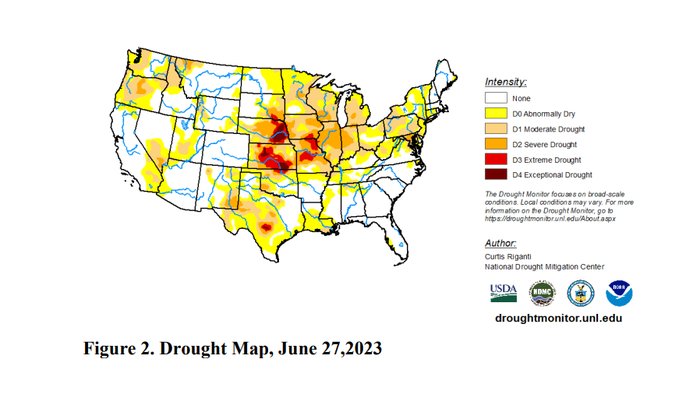
Lack of rain has hampered pasture conditions (see Figure 3) but more recent rains have provided some relief allowing both corn and hay fields to improve considerably.
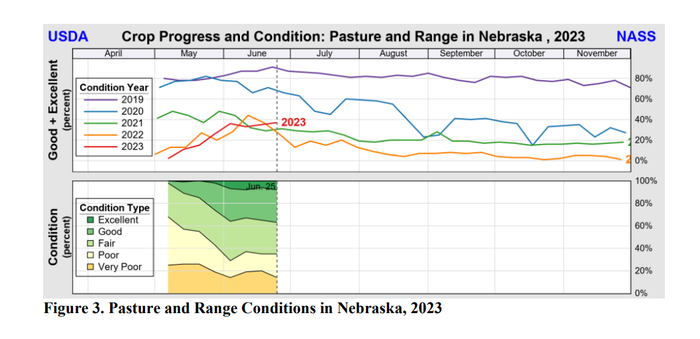
The concern is that decreasing pasture and higher feed costs would continue to cause cow liquidation. Putting that into our example of “what can I pay for a replacement cow?” indicates that if cow harvest continues due to drought, it could continue to pull up calf prices and thus we could pay more for a replacement cow. However, it could also increase costs to raise cows in drought-affected areas. Beef cow slaughter has regulated over highs in 2022 towards the 5-year average even though drought has continued in some areas (see Figure 4). So, the likelihood of drought impacting future cull rates and cow replacement cows appears low.
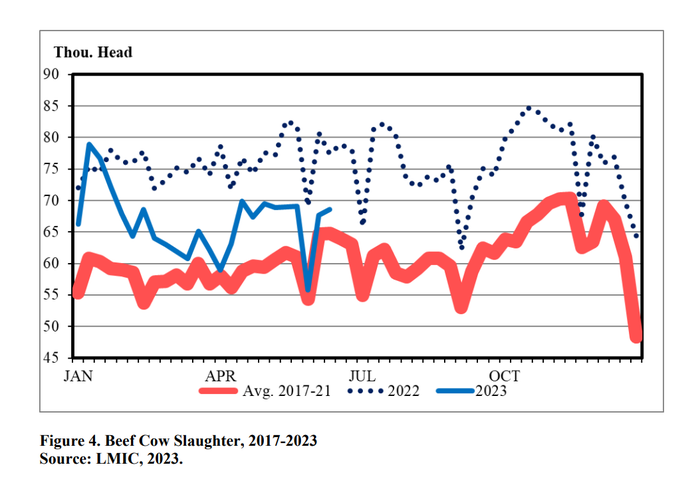
You May Also Like
